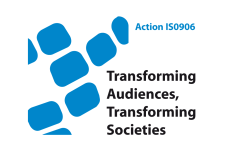- About the Action
- Events
- PhD workshop - Ljubljana 2014
- Action Open Conference - Ljubljana 2014
- New Media and Participation conference - Istanbul 2013
- Belgrade meeting 2013
- Media literacy research and policy - Brussels 2013
- ICA Pre-Conference 2013
- Tampere meeting 2013
- Budapest workshop 2012
- Milan meeting 2012
- Brussels PhD workshop 2012
- Brussels Action workshop 2012
- London meeting 2011
- Zagreb Conference 2011
- Lisbon meeting 2010
- Affiliated events
- WG 1
- WG 2
- WG 3
- WG 4
- Cross-WG
- Output
Transnational digital audiences? “Moral economy of the households” and digital television
Aroldi, P., Vittadini, N. (2010). Transnational digital audiences? “Moral economy of the households” and digital television . ECREA 2010: "3rd European Communication Conference". 12-14 October.
http://www.ecrea2010hamburg.eu/Abstract: Media system in Europe is facing a transformation characterised by the emergence of a new digital ecology (Benkler, 2006) a hybrid system of technologies, cultural products, players and consumer activities and practices. Media are turning into networked and pervasive commodites (Jenkins 2007) and audiences are becoming productive and mobile social networks (Varnelis, 2008). In this new media ecology audiences are re-defining values and uses of “old media” such as Television. This process is driven, for example in Europe, by the conversion of analogue television into DTT: the so called “switch off”. Although this kind of re-appropriation of “old media” has some common features, it takes place in different ways producing different transnational constellations of devices and practices. An emerging question in audience studies then is how we can explain and predict differences among re-appropriation paths? Do they depend on differences in audience groups and on which kind of differences? Many studies have highlighted the relevance of national cultural variables in differentiating appropriation processes of digital technologies (Haddon, 2005). Among cultural variables is more and more emerging the relevance of the complex articulation of technological equipments; cultural consumption models; time-space management styles and social or concept orientation of the households. This articulation can be defined as “moral economies of the households” (Silverstone & Hirsch, 1992). Nevertheless few research projects have already made an attempt to use the configuration of the “moral economy of the households” as a complex set of variables affecting and differentiating the re-appropriation paths of media in the new digital ecology. The paper will describe a research developed, in 2009, at the OssCom (Research center on Media and Communication of the Catholic University of Milan) aimed at analysing how differencies in “moral economies” can be used in defining different paths of re-appropriation of television in front of two changes: the development of the pay tv offer (on Satellite Tv and on DTT) and the “switch-off” of analogue television in favor of DTT. The methodology integrated different tools. A set of semi-structured interviews, on a sample of 70 households, has been used to define different configurations of moral economies and attitudes towards digital television. The sample has been selected taking in account place of residence; age groups (25-34; 35-54; 55-64), composition of the households (for example presence or absence of children); education levels. A set of in deep etnographies has been aimed at study each audience configuration. They included in deep interviews, digital ethnographies, and collaborative ethnographies (involving intervieweed in producing visual and textual material). The research results will be presented underlining how differencies of the “moral economy of the households” can be used in defining and predicting different processes of re-appropriation of television in the new media ecology. The paper will also suggest how this differencies can be useful for a cross-country comparison of digital conversion of the households referring not only to set of cultural variables country based, but to transnational consumer attitudes and profiles.

